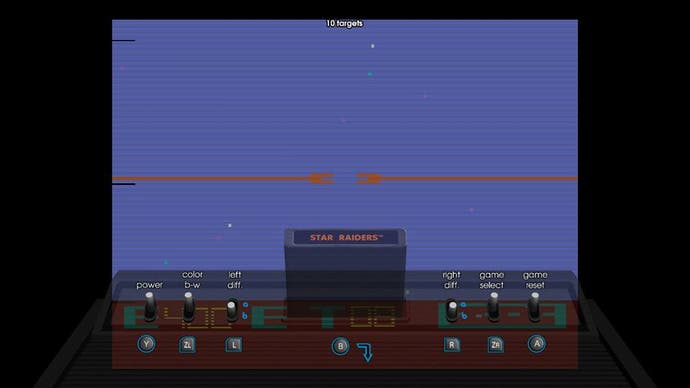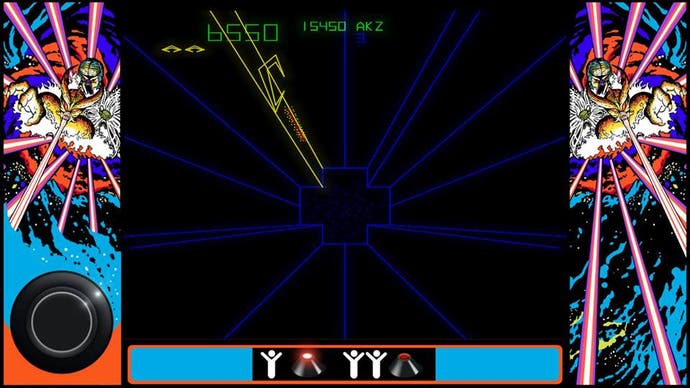Back when Atari made art
Jobs' lot.
The best game I ever played, I played over one single weekend. And I've spent years tracking it down since.
Put some of that time down to the haziness of memory; that single weekend was when I was eight years old, spending a weekend around a friend I'd made in the caravan camp over the summer holidays. I can't remember his name. I don't think I ever saw him again after that, even, and for some years afterwards I couldn't even remember the name of the game. All I remember is perching inches away from a TV hooked up to a Atari 5200 and sitting on the floor of his bedroom, and getting lost in something totally sublime.
There were starfields and dancing motes of star dust that would stream into slick lines when you entered hyperspace, spaceships that move with dazzling conviction and space stations to dock in. There were arcane controls to struggle with, galactic charts to decipher and the sense, for the first time ever for me, of being transported wholly to some far-off, wondrous place.
That weekend lodged itself into the back of my brain, little recollections of it returning as other details disappeared into the void. For some time, I'd convinced myself it was Elite - it must have been Elite - until I realised that came out far too late to grace any of Atari's early consoles. Activision's Starmaster? Nope, that doesn't seem quite right.

It was only 25 years after that weekend that I stumbled upon the answer while browsing through old GDC talks. Star Raiders! It's only the past week that I've got to play it again, thanks to Atari Flashback Classics, that had a belated launch on the European Switch store last month. It's every bit as wonderful as I remembered. There's that same low rumble of the spaceship, sounding like the background drone in the cabin of a transatlantic flight, the same wonder at a universe being conjured from just a handful kilobytes of code, and the same sense of being pulled into another world entirely.
Atari's output for its home machines can come in for a rough ride in this day and age; they're too crude for modern tastes, too basic to sustain the attention span of the contemporary player. Bollocks to all that, though. These things are just as magical as they were in their day, maybe even more so; slices of abstract purity conjured up from the black depths of old CRT TVs, there's something of the occult to them. They're illicit and weird, like rituals played out in big blocks of colour. I always half-expect to turn around and see the ghost of some frazzled Atari programmer with scruffy hair, a Bermuda shirt and smelling of Sunnyvale's strongest weed, conjured up by whatever mystical code they committed to silicon back in the early 80s.
It's easy to forget, in all the fuzzy nostalgia that's smothered Atari's golden age ever since, that these things were products of a west coast that was recently at the epicentre of a cultural revolution, and whose designers were products of the liberal philosophies that coursed through San Francisco at the time. These things are art, and art of a purity that's rare in contemporary gaming. They're works of abstract expressionism, worlds with their own logic and rules and physics and told in blocks of colour that could well be pixel translations of Barnett Newman or Clyfford Still.

It's one of those odd inversions particular to video games; other visual mediums have evolved from realism to the more visceral urges of expressionism, whereas games have strived over the years to attain more realism in their worlds. All of which has always led me to believe that these 8-bit games aren't the primitive beginnings of a medium; instead, they're their own thing, an end in themselves and a little bubble of mad brilliance.
Which is basically me trying to say: good lord I've had a lot of fun with Atari Flashback Classics. Given the shufflings, stumblings and missteps by those who've marched under the Atari banner in recent years, it's easy to forget the magic that once emanated from smoky shop floors in California. That particular Atari - the one founded by Bushnell and Dabney, the one that pioneered so much in the arcades and later in millions of homes with the VCS - ceased to be in 1984, though you can probably place the exact time of death some time before then. Atari Flashback Classics is a reminder of when the likes of Asteroid, Tempest and Missile Command ruled the world - even if the package can in places feel like a product of the less than stellar Atari of today.
There's some 150 games here, culled from the video game's first golden age of which Atari were such an integral part, and taking in everything from 1972's Pong to the Swordquest series from towards the end of the Atari 2600 - and the original Atari's own - life in 1983. It's not exactly a comprehensive list, despite the large numbers - it's important remembering that when it comes to the home console library, this is a collection of Atari games, so there's none of the third party classics such as Moon Patrol, Pac-Man or Space Invaders.
It is, though, a fascinating list, full of oddities and curios. There's lesser-spotted arcade titles like 1977's racing game Super Bug, and the even lesser-spotted Maze Invaders - an unreleased Pac-Man-alike from 1981. Sometimes, the list is plain odd - hidden amongst the Atari 2600 games is Adventure 2, a sequel to Warren Robinett's much-loved and deeply influential 1980 game. Except this, I think, is the sequel that cropped up on the Atari Flashback in 2005, a remix of sorts created for one of the plug-in-and-play boxes made by Flashback Classics' developer AtGames.

Not that you'd know any of this, seeing as there's no context, explanation or even a simple timeline for any of this. Instead, you get a numb alphabetical list of what's on offer and, for the console games at least, a scan of the relevant manual (which does mean that Swordquest, a spin-off Adventure and an ARG of sorts which offered a prize pool of $150,000 that was sadly never claimed, gets its full comic-book accompaniment). It's disappointingly no-frills, though you do get glorious marquee artwork wrapped around the screen when playing arcade games, and the ability to conjure up the VCS console when playing the home games so that you can tinker with the various settings.
So, that's the disappointing stuff. Let's talk about the good stuff, because there's plenty of that. The arcade selection hosts some certified bangers, and they've been pretty well served. The vector glow of the likes of Tempest and Asteroids is preserved well, that phosphorous brilliance emulated neatly (and you can adjust the brilliance of it as you see fit). Major Havoc, that madcap mix of different genres and one of the very last vector games, gets a welcome runout, and there's a purity to these classics that means they haven't aged a bit.
They're games that corral together precision and chaos until something sublime results, and their pull and sense of wonder hasn't dulled in the slightest. Go beyond the classics, and there's still a novelty factor to much that's on offer - novelty, after all, was the key edict of a developer that never wanted to repeat itself, coming up with new problems to solve, and then new ways to solve those problems, with every new release. So you've got variations on the racing theme with Fire Truck, Monaco and Super Bug (all still enjoyable today, with the JoyCon stick being put into practice as a substitute for the steering wheel, allowing you to spin it wildly, or you can always use touchscreen controls for the on-screen wheel should you prefer). There's Missile Command (again helped along with touchscreen controls that go some way to emulating the original trackball) and its spiritual successor Liberator.
Really, though, it's the VCS stuff that stirs my heart. The collection is staggering, selectable by those little round-edged cartridges with titles spelled out in that evocative round-edged font. There's repetition and filler here - plenty of it - and the emulation may not be the best with limited options for scanlines and the like, but it does a wonderful job of conveying how analogue the VCS felt. There's a console overlay that can be brought up at any point, where you can flick the various levers to impact certain gameplay parameters.
I loved how abstruse it was all then, and - for better and for worse - it still feels that way today. This collection isn't the measure of the likes of Digital Eclipse's recent SNK one, and it's short on features, but most importantly it does feel faithful. It captures the sense I used to have around my old wood-panelled VCS - that this was a piece of equipment that had come straight from a laboratory, like a playable oscilloscope that had the cold, hard face of science yet translated into such richness. And what it conjured up was, more often than not, nothing short of art.


